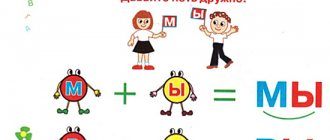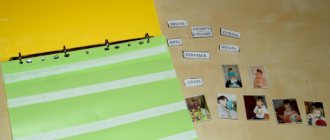Long-term planning of work with children 3-4 years old with general speech underdevelopment of levels 1 and 2
In addition to classes for the development of understanding of speech, active speech, the formation and improvement of the grammatical structure of speech, the development of verbal communication and coherent speech, games, exercises, and classes are conducted for the children of the group to develop auditory attention, phonemic hearing and perception, visual attention and perception, the prosodic aspect of speech , education of general speech skills.
In such classes, children learn to recognize and distinguish non-speech sounds and sound signals consisting of 3-4 words of sounds; a sense of rhythm, auditory-verbal memory, visual memory and attention develops; children develop correct speech diaphragmatic breathing and long speech exhalation; Speech imitation, intonation expressiveness, and rhythm of speech develop.
Throughout the first year of study with children with
OHP 1 and 2 levels, the teacher carries out targeted work on the development of articulatory motor skills, fine motor skills and the psychological basis of speech.
For working with children, complexes have been selected that combine exercises aimed at developing articulatory motor skills, fine movements of fingers, breathing, voice, and the development of the child’s emotional sphere. Complexes are associated with lexical material accessible to children. The game form of teaching the material is most consistent with the psychological capabilities of preschoolers.
Exercises to develop articulatory and fine motor skills are carried out daily so that the motor skills developed by children are consolidated and become stronger. The work takes at least 5 minutes. Articulation exercises are performed in front of a mirror, sitting on a chair, as shown by an adult in stages. The execution of the exercise is also checked step by step.
An important stage of correctional and developmental work in a group is the individual work of the teacher with the child.
Individual work is carried out after subgroup classes and children’s rest. The duration of individual lessons does not exceed 10 minutes. Planning is carried out on the basis of the examination of the child, the recommendations of the State Medical Inspectorate and the psychologist. During the year, two types of individual work planning are used: long-term (for the whole year) and calendar-perspective (for one month). This contributes to more in-depth and high-quality work with each child throughout the school year. Such planning makes it possible to take into account the characteristics of the child’s speech and mental development, consolidate the material covered, and determine the dynamics in development.
It is impossible to talk about the success of correctional and developmental work in a speech therapy group without close contact between the teacher and the parents of preschool children and without their parents’ help. Introductory conversations are held with the parents of the pupils; messages and consultations are offered at the parent corner stands; parents are invited to individual conversations regarding the state of their children’s speech development; are actively involved in the educational and development process.
Long-term planning in the senior speech therapy group (OSG)
PERSPECTIVE PLANNING OF THE WORK OF A Speech Pathologist in the Senior Group/ (GENERAL SPEECH UNDERDEVELOPMENT)
Teacher-speech therapist Ryzhova O.V.
1. Examination of the state of children’s speech (September 2 weeks).
2. Teaching children.
I PERIOD OF TRAINING
(September October November)
VOCABULARY
. Lexical topics: “Professions of the village”, “Gifts of autumn”, “Domestic and wild animals in autumn”, “I am growing healthy”, “Knowing myself”, “Me and my family”, “Professions of my parents”, “Native country”, “Symbols of Russia”, “Moscow is the main city of Russia”, “Winter is in a hurry to visit us”
Grammatical structure of speech
1. Practical mastery of nouns with a diminutive suffix (game “Big - Small”).
2. Practical mastery of singular and plural nouns (game “One - Many”).
3. Mastering the possessive pronouns mine, mine in combination with masculine and feminine nouns (my scarf, my fur coat).
4. Converting verbs of the imperative mood of the 2nd person singular into verbs of the indicative mood of the 3rd person singular
number of the present tense (drink - drinks, eat - eats, my - washes).
5. Agreement of nouns with adjectives and verbs, strengthening the use of simple prepositions in speech:
on – with, in – from.
Connected speech
1. Development of the ability to listen to spoken speech and answer questions from a speech therapist
2. Mastering the skill of drawing up simple proposals on questions and demonstrating actions.
3. Making simple sentences based on the picture.
Phonetic-phonemic side of speech
1. Clarification of the pronunciation of vowels: [a], [u], [o], [i], [s], [e] (sound combinations [au], [ua], [ia])., consonants [p, p ”],[m,m”],[t, t']?[m,m']
2. Development of auditory attention and auditory memory.
3.Introduction to letters. Learn practical concepts Consonant “hard”, “soft”
4. Preparation of the articulatory apparatus for producing sounds (articulatory gymnastics).
5. Isolating vowels and consonants from a number of sounds, from one- and two-syllable words (Anya, poppy, etc.).
P TRAINING PERIOD
(December January February )
VOCABULARY
. Lexical topics: “Winter fun”, “New Year is in a hurry to visit us”, “The Christmas tree has come to visit us”, “New Year, the children began to dance” “Signs of Mother Winter”, “Winter Olympics”, “Winter nature”, “How animals live in winter”, “Heroes of our country”, “Our army”, “February 23 holiday”
Grammatical structure of speech
1. Formation of relative adjectives,
Agreement of numerals with nouns,
Drawing up proposals for demonstration actions.
2.Use of prepositions ( on, over, under, in, for, from, because of, from under
)
Retellings of texts
3. Agreement of nouns with singular and plural verbs of the present tense (Sasha is sculpting. Children are sculpting. Games: “Who screams how?”, “Who moves how?”).
3. Practical mastery of the endings of masculine and feminine past tense verbs (Tanya blinded. Vova blinded).
4. Practical use of simple prepositions in speech: on, in, under, for, at, to, with, on, above.
Connected speech
1. Learn to select words that have opposite meanings.
2.To consolidate knowledge about family ties.
3.Develop an understanding of logical and grammatical structures.
4. Consolidating the skills of constructing a sentence of 3-4 words.
5. Drawing up a description of objects according to perception (using a model).
6. Verbatim retelling of short stories and fairy tales (with the help of a speech therapist).
7. Learning simple poems.
General speech skills
1. Continue working on developing a long exhalation (exercises “Blow out the stubborn candle”, “Snowflakes are flying”, etc.). The duration of exhalation is on a count of 4.
2. Practicing the unity of 3-4 vowels (exercise “Let’s pull the rubber bands”: a-o-u, a-o-u-i).
3. Work on the strength of exhalation (exercises: “Mill” (blow on a turntable), “Kick the ball into the goal” (rolling a ball along a groove)).
4. Development of voice strength: loud, medium, quiet.
Exercises: “Beep”: (oo-oo), “Echo”: (au-au-au).
Phonetic-phonemic side of speech
1. Sound and letters[G][G'], [G]-[K][B] [B'] [B] - [P][X][X'][K]-[G]-[ X] [D] [D'] [T]-[D] [V][V'] [F] [F'] [S]
2. Introduce the sound and reinforce the correct pronunciation. Develop the skill of dividing words into syllables. Learn to distinguish sounds by deafness and voicedness. Development of auditory perception, attention, memory (practice to distinguish sounds by tonality, pitch, duration, and also pronounce reflected sound and syllable series).
3. Clear pronunciation and distinction of sounds. Learn to characterize each sound. Exercise in determining the place of sound in a word. Develop phonemic processes (sound analysis of syllables, words).
III PERIOD OF TRAINING
(March April May )
VOCABULARY.
Lexical topics: “Mom’s holiday”, “Traditions and customs of our people”, “My native land”, “Folk toys”, “Spring is red”, “Animals and birds in spring”, “Space distances”, “Heroes of the Second World War”, “Spring Festival and Ore”, “Great Victory Day”, “Summer will soon come to us”, “My favorite kindergarten”, “Summer, oh summer!”
Grammatical structure of speech
1. Formation of singular and plural nouns using the suffixes -onok, -enok
2. Mastering the skill of agreeing adjectives with nouns in gender and number (What is the sky like? - Blue. What kind of spring? - Warm. What kind of air? - Clean).
3. Practical use of prefixed verbs of motion (The bird flew in, flew in, flew out, flew away).
4. Consolidation and use of nouns in the dative case in speech
5. Expanding knowledge of the meanings of prepositions in - from, under - above, behind - in front.
6. Mastering the most accessible antonymic relationships between words (tall - low, thick - thin, kind - evil).
Connected speech
1. Work on dialogical speech (dialogue with peers).
2. Learn to ask and answer questions.
3. Retelling short texts.
4. Compiling a story based on samples (about a toy, an object, a picture - first the subject, then the plot).
General speech skills
1. Continue working on a strong and long exhalation (duration of exhalation on a count of 4-5).
2. Work on voice modulation (raising - lowering the voice). Exercises “Bug” (w-w-w), “Cuckoo” (cuckoo, cuckoo).
3. Work on developing the correct tempo and rhythm of speech (
4. Nurturing intonation expressiveness of speech (using nursery rhymes, poems, dramatization games).
Phonetic-phonemic side of speech
1.Introduction to Sounds and Letters[С]-[Ш].[З], [Ф],[С]-[С'], [З]-[З'] [Л]-[Л'] [Ц ,[H]
2. Learn to distinguish sounds by acoustic and articulatory characteristics. Strengthen the skill of dividing words into syllables. Develop phonemic processes (“Hear a given sound in a word and determine the place of the sound in the word”).
3. To consolidate the differentiation of sounds according to the place of formation, hardness and softness. Develop the skill of distinguishing words that are similar in sound composition. Develop sound analysis in syllables and words (laying out sound patterns). Reinforce concepts:
“hard, soft, voiced, voiceless, syllable, word, sentences” Position of sounds in a word. Fix to determine the sequence of sounds in syllables and simple words.
Appendix No. 2
Approximate long-term planning in the preparatory group.
1. Examination of the state of children’s speech (September 2 weeks).
2. Teaching children.
I PERIOD OF TRAINING
(September October November)
Expansion and clarification of the dictionary on the topics “Autumn”, “Vegetables”, “Fruits”, “Berry”, “Mushrooms”, “Toys”, “Trees”, “Migratory Birds”, “Wild Animals”, “Dishes”, “Products” ", "Furniture",".
Development of general speech skills
1.Development of clear, coordinated movement of the organs of the speech apparatus.
2. Teaching children to take a short and silent breath (without raising their shoulders), and to breathe out calmly and smoothly (without puffing out their cheeks).
3.Work on the formation of diaphragmatic breathing.
4.Work on the soft attack of the voice. Developing in children the ability to use a loud and quiet voice.
Sound pronunciation
1.Development of the speech apparatus, preparation for production of sounds (conducting general and special articulatory gymnastics).
2. Clarification of the pronunciation of vowels and the easiest consonants
3. Establishment and initial consolidation of incorrectly pronounced and missing sounds in children’s pronunciation (individual work).
Working on the syllable structure of a word
1.Work on monosyllabic words with a combination of consonants at the beginning and end of the word (table, bridge).
2.Work on two-syllable words without consonants (fly, house).
3.Work on three-syllable words without consonants (raspberry, cornflower).
Development of language analysis, synthesis, representations (phonemic, syllabic, sentence analysis)
1. Development of auditory attention on the material of non-speech sounds (sounding toys, claps).
2.Acquaintance with vowel sounds: [a], [o], [u], [e], [s], [i].
3.Analysis and synthesis of sound combinations of 2-3 vowel sounds (au, ua, oue, etc.)
4. Isolating a vowel at the beginning of a word (Anya), at the end of a word (saw), in the middle of monosyllabic words (ball, bull, table, etc.).
5. Selection of words for vowel sounds.
6.Introduction to consonant sounds
7. Isolating the studied consonant sounds from a word (beginning, end, middle).
8.Introduction to the concepts of “vowel sound” and “consonant sound”, “sound” and “letter”, “hard consonant sound” and “soft consonant sound”.
9.Analysis of reverse and forward syllables with studied sounds (om, mo, etc.)
10. Complete sound analysis and synthesis of three-sound WORDS WITH studied sounds (willow, poppy, etc.)
11.Introduction to the letters A, O, U, E, I, Y, M, B, D, N, V, G, P, T, F, K, X.
12. Laying out letters, reading forward and backward syllables with studied letters.
Grammatical structure of speech (based on lexical topics of the period)
1.Practice case endings of singular nouns.
2. Convert nouns in the nominative singular to the plural.
3 Agreement of verbs with singular and plural nouns (the apple grows, apples grow).
4. Agreement of nouns with adjectives in gender, number, case.
5. Agreement of nouns with possessive pronouns my, mine, mine, mine.
6. Formation of nouns with diminutive suffixes on the topic “Vegetables, fruits”, etc.
7. Agreement of the numerals two and five with nouns.
Development of coherent speech
1. Compilation of simple common sentences.
2.Training in the ability to ask questions and answer questions with complete answers.
3. Training in writing descriptive stories on the topics: “Vegetables”, “Fruits”, “Berry”, “Trees”, “Migratory Birds”, “Wild Animals”, “Utensils”, “Furniture”.
4.Work on dialogical speech (using literary works).
5.Training in retelling short stories and fairy tales (literal and free retelling).
Development of fine motor skills
1. Outlining, painting and shading using stencils (based on lexical topics of the first period).
2. Compilation of figures, patterns from elements (based on the model).
3.Working with lacing and small mosaics.
4.Printing completed letters in notebooks.
I I
PERIOD OF TRAINING
(December, January, February)
Development of general speech skills
1. Continue working on breathing, voice, tempo and rhythm of speech for all children.
2.Introduce different types of intonation: narrative, interrogative, exclamatory.
Sound pronunciation
1. Continue work on identifying sounds that are incorrectly pronounced and missing in children’s speech (individual work).
2. Automation and differentiation of delivered sounds.
Working on the syllable structure of a word
1. Work on the structure of words with a combination of consonants at the beginning of the word (book, flower), in the middle of the word (window, stick, pocket), at the end of the word (joy).
2.Work on the syllabic structure of three-syllable words with a combination of consonants at the beginning of the word (sour cream) and in the middle of the word (speck of dust, pencil).
Development of language analysis, synthesis, representations (phonemic, syllabic, sentence analysis
1.Introduction to the sounds [s]-[s'], [z]-[z']; [ts], [sh], [zh], [sh]> [h] and the letters S, 3, Ts, Sh, Zh, Shch, Ch.
2. Teach a complete sound analysis of words like: flour, closet, stork, cat (based on the studied sounds).
3. Teach children to distinguish between hard and soft consonants by ear (when drawing up a word diagram, denote hard consonants in blue and soft consonants in green).
4. Teach children to transform words by replacing or adding sound.
5. Teach children to divide words into syllables, introduce the concepts of “word”, “syllable as part of a word”.
6. Introducing the concept of “sentence”, drawing up a graphical diagram of sentences without prepositions, and then with simple prepositions.
7.Introduce children to basic spelling rules:
a) separate writing of words in a sentence;
b) period at the end of the sentence;
c) the use of a capital letter at the beginning of a sentence and in proper names;
d) spelling of the letter I after the letters Zh, Sh.
8. Continue familiarization with letters, learn to form words from the letters you have learned.
9.Teach syllable reading of words.
Vocabulary
Expansion and clarification of the dictionary on the topics: “Winter”, “Winter fun”, “Wintering birds”, “Wild animals”, “Animals of the north”, “Animals of hot countries”, “Clothing”, “Shoes”, “Hats” ", "Defender of the Fatherland Day", "Family", , "Transport" (ground, underground, water, air).
Grammatical structure of speech (based on lexical topics of the period)
1Reinforcing the use of case endings of nouns in the singular and plural.
2. Agreement of adjectives with nouns in gender, number and case.
3. Agreement of nouns with numerals.
4. Formation of names of baby animals.
5. Formation of possessive adjectives, formation of relative adjectives from nouns (on lexical topics of the II period).
6. Formation of reflexive verbs, differentiation of perfective and imperfective verbs.
7. Clarification of the meaning of simple prepositions of place (in, on, under, above, U, behind, before) and movement (in, from, to, from, on, through, for). Learn to form sentences with prepositions using prepositional symbols.
Development of coherent speech
1. Strengthen the ability to independently compose descriptive Stories. 2. Teach children to retell and compose a story based on a picture and a series of pictures.
1.Work on the development of finger motor skills (exercises for
fingers).
Development of fine motor skills
2.Work on the development of constructive praxis.
3. Continue work on outlining and shading figures (on topics of the II period).
4. Make it more difficult to work with a pencil: tracing along the contour, shading, working with a pencil according to the cells in the notebook.
5. Compiling letters from elements.
6.Printing letters, words and sentences in notebooks.
III PERIOD OF TRAINING
(March April May )
Development of general speech skills
1. Continue working on speech breathing.
2. Continue working on the tempo, rhythm, and expressiveness of speech.
Sound pronunciation
1. Continue work on identifying sounds that are incorrectly pronounced and missing in children’s speech (individual work).
2. Automation and differentiation of delivered sounds.
Working on the syllable structure of a word
1. Consolidation of the syllabic structure of two- and three-syllable words with a combination of consonants.
2.Work on the syllable structure of two-, three-, four-, five-syllable words with a complex sound-syllable structure (square, motorcycle, apartment, screwdriver, trolleybus, water supply, electricity, etc.).
Development of language analysis, synthesis, representations (phonemic, syllabic, sentence analysis
1.Introduction to the sounds [i], [l], [l'], [r], [r']. Introducing the letters I, L, R, L, I, E, E, Yu.
2. Teach sound analysis of words of 3-6 sounds without a visual basis, selection of words according to models.
3. Strengthen the skills of syllabic analysis of words and analysis of sentences.
4.Teach the skill of syllable-by-syllable continuous reading of words, sentences, short texts.
5. Introduce children to two ways to indicate soft consonants in writing.
a) using a soft sign at the end and in the middle of words (horse, skates);
b) using the vowels I, Ya, E, Yo, Yu.
Vocabulary
Expansion and clarification of the dictionary on the topics: “Spring”, “Mother’s holiday”, “Birds”, “Professions”, “Tools”, “May 9 Holiday”, “School supplies”, “Summer”, “Insects”.
Grammatical structure of speech (based on lexical topics of the period)
1. Clarify the meaning of simple and complex prepositions (because of, from under), consolidate the correct use of prepositions.
2. Practice the correct use in speech of various types of complex sentences with conjunctions and allied words.
3. Learn to form adverbs from adjectives (fast - quickly), forms of degrees of comparison of adjectives (faster - the fastest).
4.Teach the selection of related words, synonyms, antonyms, homonyms, and the composition of sentences with these words.
5. Strengthen the ways of forming new words using prefixes and suffixes, by addition (steamboat, plane, cook).
1. Strengthening the ability to independently compose descriptive stories, stories based on a plot picture, a series of plot pictures, from experience.
2. Compilation of various types of complex sentences with conjunctions and allied words.
3 Teaching children to write stories from experience and creative stories.
Development of fine motor skills
1. work on the development of finger motor skills (exercises for fingers).
2. work on the development of constructive praxis.
3. Continue working on outlining and shading the shapes
4. making letters from elements
5. typing letters, words and sentences in notebooks.






